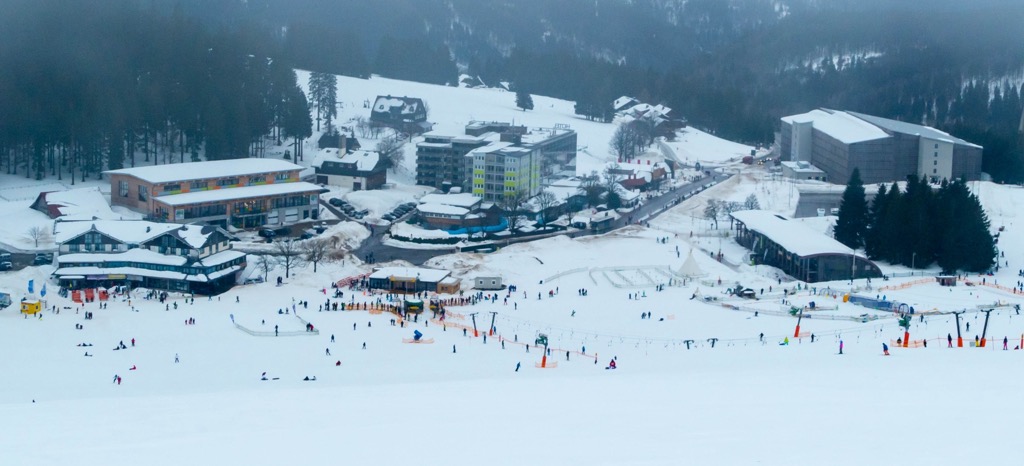Get PeakVisor App
Sign In
Search by GPS coordinates
- Latitude
- ° ' ''
- Longitude
- ° ' ''
- Units of Length
- Temperature

Yes
Cancel
Share ×

Scan the QR code and open PeakVisor on your phone
❤ Wishlist ×
Choose
Delete
The crown jewel of the Black Forest, Feldberg is the largest and highest ski resort in Germany outside of the Alps and the oldest in the country. Located in the state of Baden-Würtemburg, Feldberg lies within the Breisgau-Hochschwarzwald district. The resort has about 30 km (19 mi) of pistes, a 9 km long ski touring route, and various cross-country and uphill trails. The pistes range from bunny hills suitable for first-timers to steep runs that present challenges even for experts used to high-altitude skiing.
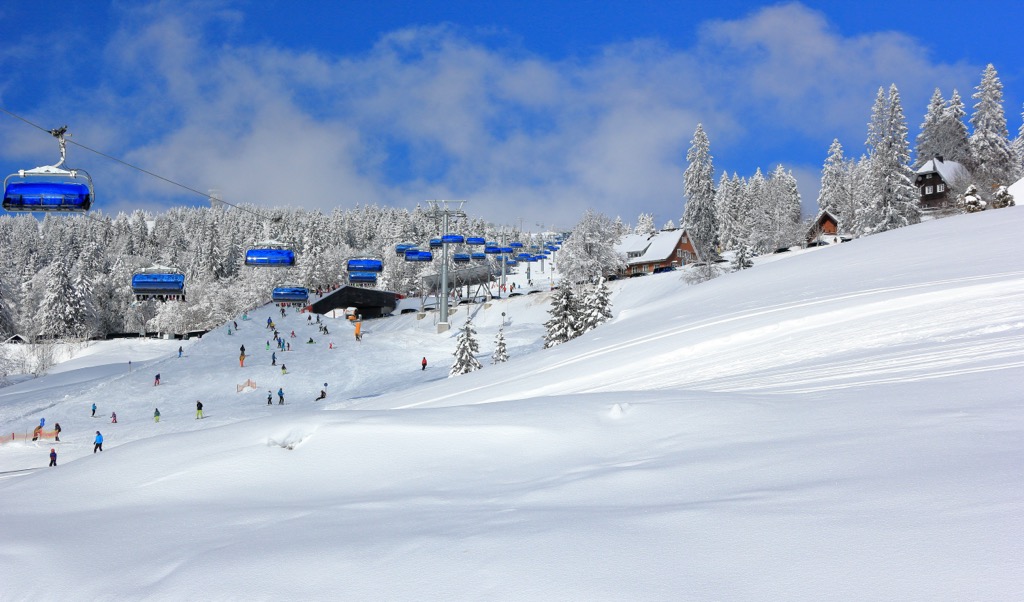
Location
The Felberg ski area is 40 km (25 mi) southeast of Freiburg im Breisgau (hereafter just ‘Freiburg’), a charming university city of about 230,000 people. The city sits in the shadow of the Black Forest, a mountainous and densely wooded area stretching from Feldberg in the south to Enz in the north. Schauinsland, famous for its panoramic views of the surrounding lowlands, sits near the halfway point between Freiburg and Feldberg.
The resort is nestled between two lakes popular with locals, the Titisee and Schluchsee, which sometimes freeze over.
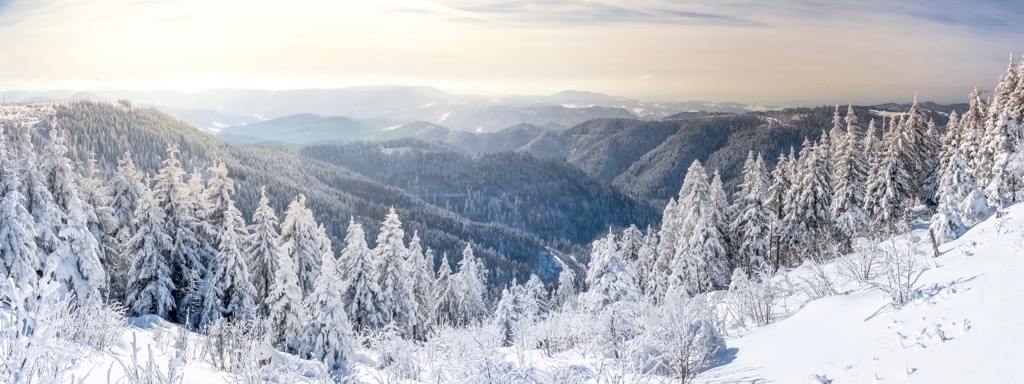
Whether you’re coming by train or car, it takes about an hour to get to Feldberg from Freiburg. The route is scenic, up and down steep slopes packed with evergreens.
Nearest Airports
At about 70 km (43 mi), the overly hyphenated EuroAirport Basel-Mulhouse-Freiburg is the nearest airport.
Public Transportation
Feldberg is well-served by public transportation. Whichever direction you’re coming from, you’ll have to take a short bus ride from the nearest train station to the ski area. If you land in Basel, you must get to Freiburg first. You can take a bus straight to Freiburg or a shorter bus to the Basel SBB train station and proceed by rail.
Regional trains leave Freiburg Station, heading toward Feldberg every 30 minutes. After 40 minutes on the S 1 or S 10 train, transfer off at the Titisee. Depending on your timing, you’ll get on a bus or another regional train bound for Feldberg Bärental, the closest train station to the mountain. It’s just a short 5 km (3 mi) journey to the lifts on the 3700 or 9007 bus (free with a valid ski pass). Each bus line only comes once an hour during the week, so it’s best to plan your journey accordingly. But if you get caught out in Bärental, there is a “Schnapps Museum” to idle some time before the next bus. Hitchhiking is also a viable option.
The journey from Freiburg takes about an hour and costs less than €10 each way when booked on the same day.
Feldberg has several parking options, including lots, a structure, and roadside parking.
The parking garage at Feldberghof can accommodate up to 1,200 cars. Parking here costs €2 per hour or a maximum daily charge of €15. There’s also a lot at the base of the Herzogenhornbahn. The Parkster app is required to park here.
Municipal parking is available along the Feldberg Pass between the two base areas, Feldberghof and Grafenmat. Payment is handled by machine, and prices vary. The lot in Grafenmatt is a short walk to the lifts, while the lots nearest to Feldberghof require more of a trek — one is about 800 m (0.5 mi) from the lifts, the other 1.6 km (1 mi). There are further lots past Grafenmatt along the pass, but these tend to be small, and the road is unpleasant to walk on. Skiers can get a reduced parking cost by providing proof of purchase for a ski pass as they check out.
It’s easy to get around Feldberg, which is no surprise given its size. The resort comprises two ski areas, Seebuck and Grafenmatt, separated by a short stretch of the Feldberg Pass. Thanks to a skiers-only bridge, you can ski from Seebuck (the higher of the two regions) to the Grafenmatt base area. If you need to go in the opposite direction, the Zeigerbahn starts in Grafenmatt and drops skiers near the top of the skiable area at Seebuck.
If you’re not on skis, there’s only the one road. It is possible to walk along this road (and hundreds of people do so daily). Still, given the lack of any designated pedestrian walkway in most places, the experience isn’t pleasant. Still, depending on where you’ve managed to find a parking spot, you may not have any other option.
The Pass Road is served by regional bus services, which stop in Seebuck and Grafenmatt, as well as some outlying parking lots, including the paid lot near the base of the Herzogenhorn lift.
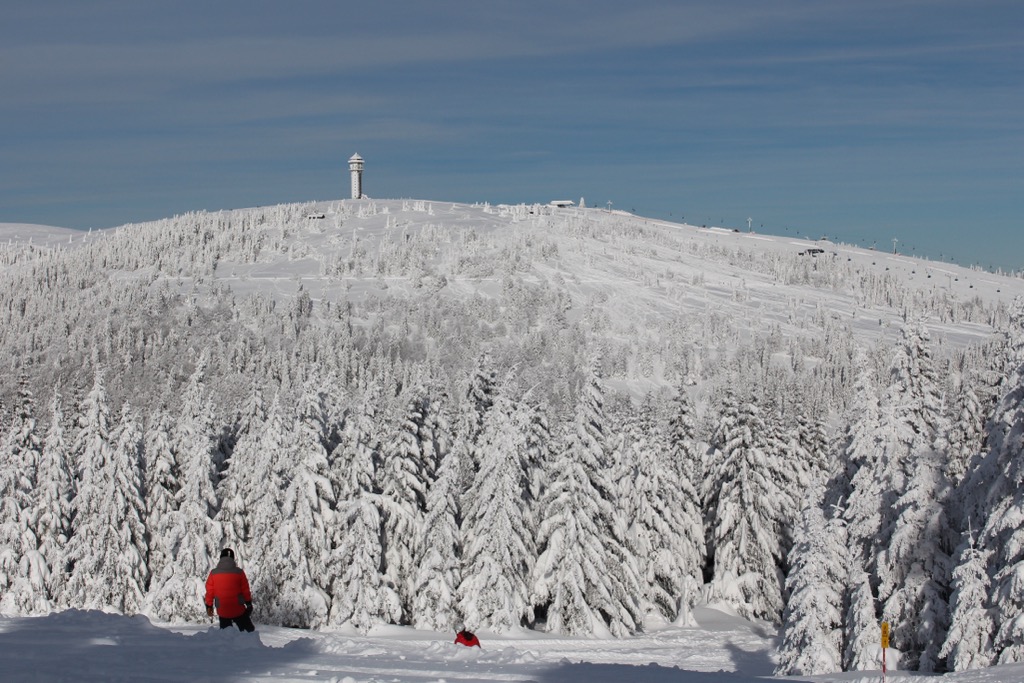
The winter season in Feldberg is supposed to begin on the first day of December, but this isn’t always the case. Depending on the year, the higher elevation areas may not open until January.
Similarly, the end of the season varies year on year. The resort aims for a December-April season, but this has been a somewhat optimistic forecast in the past few years.
The ‘peak season’ begins on December 24th and runs through January 7th. The resort considers the next three weeks (weekends excepted) part of the ‘shoulder season.’ The ‘main season’ recommences with the start of the fourth week of January and runs through the first half of March (during this period, weekends are considered part of the ‘peak season’). After this point, Feldberg is back in ‘shoulder season.’
February is the best time to ski Feldberg. There can certainly be good snow before and afterward, but the shortest month is your surest bet. February statistically sees the most snow, followed closely by January.
There is some snowmaking infrastructure in the Seebuck area, but it is relatively minimal. Given the poor snows of the past several years and the potential threats facing low-altitude ski areas like Feldberg, there is talk of expanding snowmaking at the resort, but this is controversial, and there are no public plans in the works.
In terms of temperature, Feldberg is relatively mild for a ski area. During the peak season of January and February, temperatures seldom dip more than a few degrees below freezing or rise above 5° C (41° F). By March, daily high temperatures approaching 10°C become much more common as the likelihood of rain rather than snow increases.
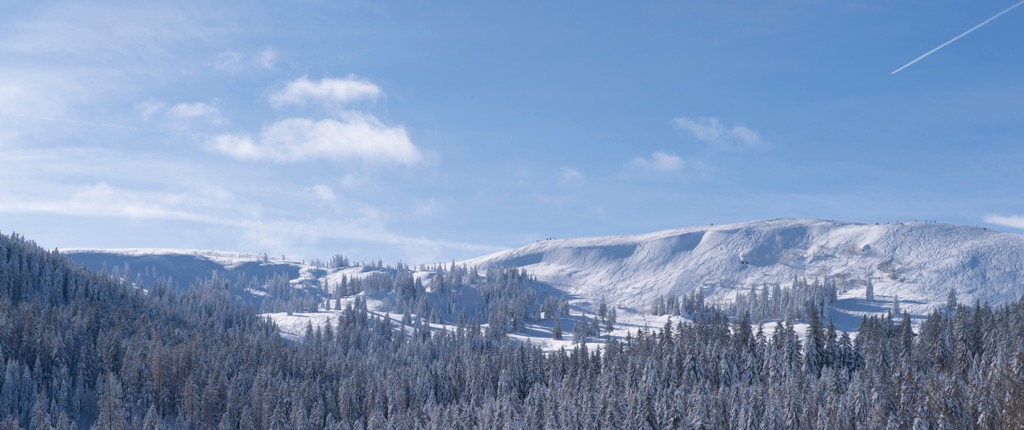
Feldberg is easy to get a handle on. The resort can be divided into two connected but distinct areas, Seebuck and Grafenmatt.
As you can see, the Feldberg side is higher than its opposite to the south, with the Feldbergbahn dropping skiers off at 1,450 m (4,757 ft) above sea level, 70 m (229 ft) higher than the top of the Herzogenhornbahn 1,380 m (4,528 ft). Ski from the top of the Feldbergbahn to the base of the Zeigerbahn over in Grafenmatt, and you’ll descend a total of 262 m (860 ft). The largest possible drop at Feldberg is achieved by skiing from the top of the Herzogenhornbahn back to the bottom, a vertical distance of about 440 m (1,444 ft).
Neither the Feldbergbahn nor the Herzogenhornbahn sits atop their respective slopes. The true peaks of each mountain lay well above the chairlifts. Naturally, some skiers will undertake the climb to reach the true summit of Feldberg, 43 m (141 ft) above the lift. The climb isn’t too tricky if you have the right equipment.
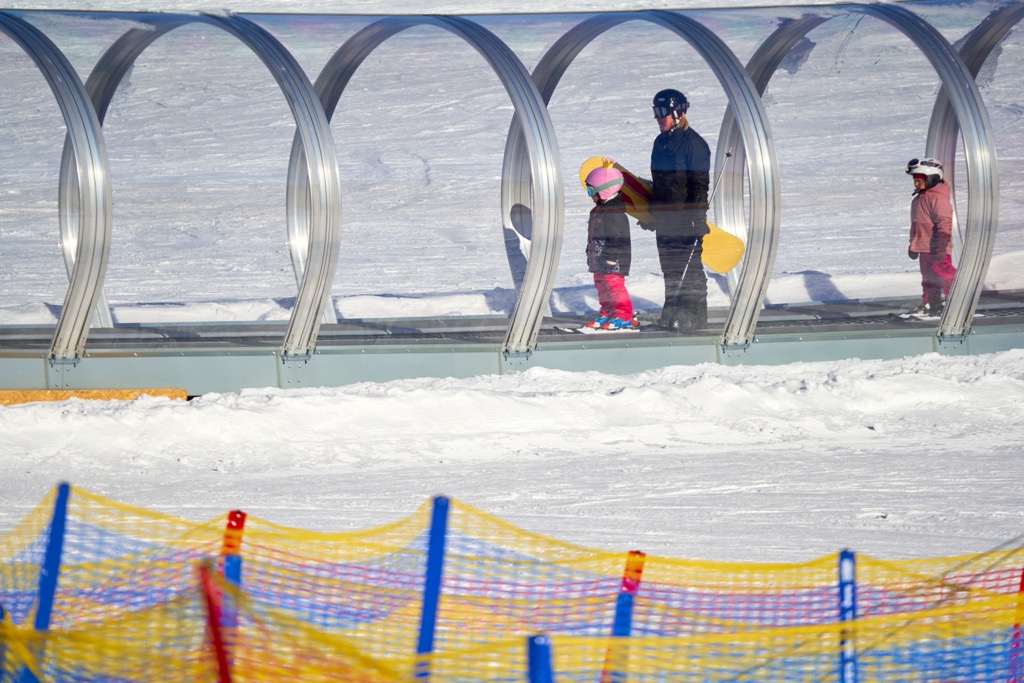
Feldberg Slopes and Lifts
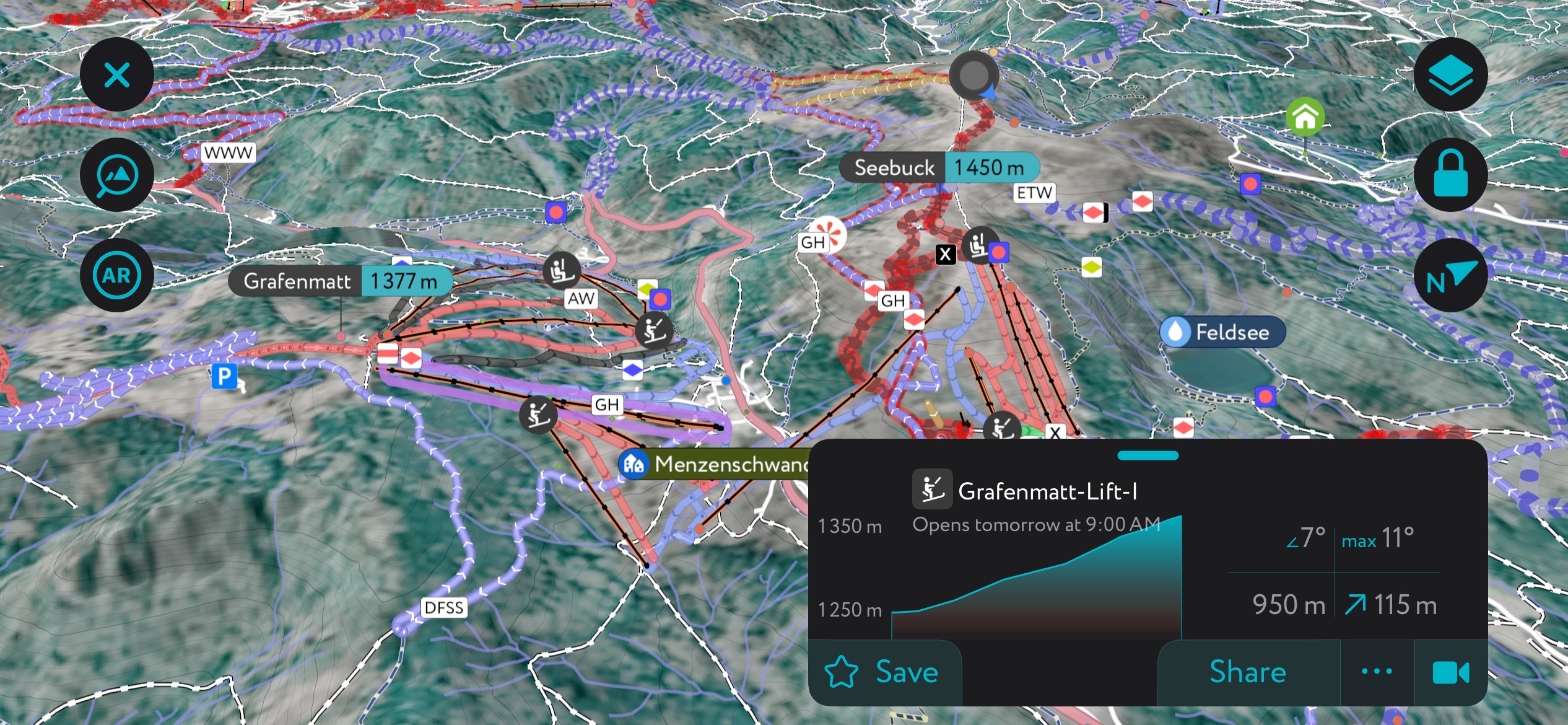
Feldberg has plenty of variety when it comes to beginner and intermediate slopes. Advanced skiers looking to tackle more challenging pistes don’t have a lot of options. Grafenmatt is the larger of Feldberg’s two areas and home to all the challenging pistes.
Here’s how Feldberg’s pistes break down in terms of difficulty:
Feldberg has just one officially designated ski touring route and no marked off-piste areas. I’ll cover your options for backcountry skiing in a later section. The mountain offers cross-country and uphill paths as well.
Seebuck lies directly below the summit of the Feldberg. It’s named for the tower at the lower part of the treeless saddle leading to the mountain’s true summit. Nearly all the slopes at Seebuck are east-facing.
Seebuck is smaller, and the terrain is less varied than you’ll find across the valley on Grafenmatt. Yet it’s also home to Feldberg’s longest piste. The ski area is wide open and largely devoid of trees (Feldberg is German for ‘Field Mountain,’ a fitting name given the unusually open terrain of the mountain’s upper reaches). It’s also favored by uphill skiers and has more areas suitable for first-time skiers. Additionally, Seebuck is home to a racecourse and a small terrain park.
Going from skier’s left to right(or from north to south), the two main lifts in Seebuck are the Seebuckbahn and the Feldbergbahn, a high-speed six-seater. The Seebuck lift is older and slower, dropping skiers off a fair distance below the heights reached by the Feldbergbahn. Though it’s largely been supplanted by the much newer Feldbergbahn, the Seebuck lift is still helpful as it ends right at the start of Piste 1, a slope that covers Feldberg’s small terrain park.
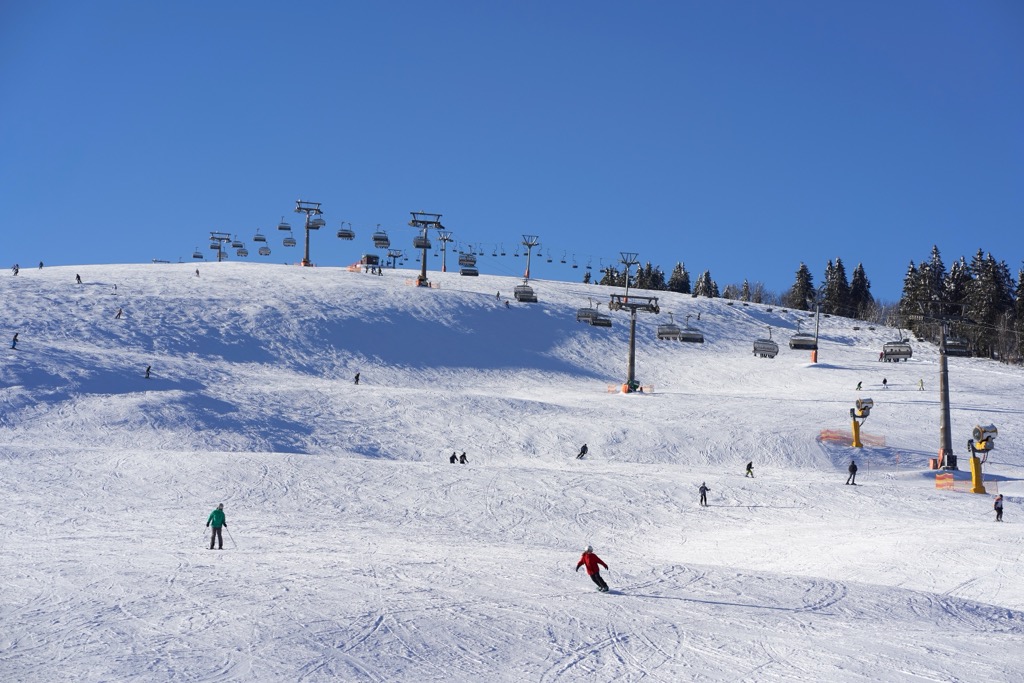
The Feldbergbahn is newer, faster, and longer, making it the better lift, provided there isn’t a line. Including the small park, the skier’s left half of Seebuck consists of 3 intermediate pistes. Ski any of these from the top of the Feldbergbahn to the base, and you’ll have covered 180 m (591 ft) of vertical distance. The runs are short, but the incline is nothing to shake your head out. Despite the short length, the speed of the Feldbergbahn means you can get some efficient laps in over at Seebuck.
Halfway between the Haus der Natur (more on that later) and the Feldbergbahn sit two neighboring T-bars. Both rise about 60 m (197 ft) and provide access to a beginner piste. Next to these (skiers’ left) are three magic carpets. The proximity of escalating terrain makes it easy to transition from more or less flat to slightly steeper terrain by moving from the carpets to the T-bars. A new skier quickly learning the necessary skills could make this transition and potentially ski on the Feldbergbahn in one day, staying on beginner pistes of increasing difficulty.
The Seebuck area has a few other amenities. There’s the Seebuck Hütte restaurant at the base of the Seebuck lift, a beer tent next to the larger structure at the bottom of the Feldbergbahn, and cafeteria-style dining in the form of the Rothaus Chalet (found by Seebuck’s twin T-bars).
The Seebuck Hütte is the most charming option in the area. The menu is similar to what you’ll find all over Feldberg, but the pace of dining is slower and the quality higher. The beer tent is one of the livelier places to grab a drink with some basic food available. The atmosphere at the Rothaus Chalet (named after Baden-Würtemburg’s much-loved public brewery) is similar. You can only get burgers, sausage, and beer, but the prices are cheap.
Seebuck also has a ticket office, ski school, rental shops, and a handful of small hotels.
Finally, there’s the Zeigerbahn, the chairlift that serves as a bridge between Seebuck and Grafenmatt. A long beginner run (Piste 5) goes from top to bottom (also accessible via the Feldbergbahn). It isn’t very steep, so it’s great for beginners looking to enjoy a long run (the piste is over 2 km / 1.25 mi long).
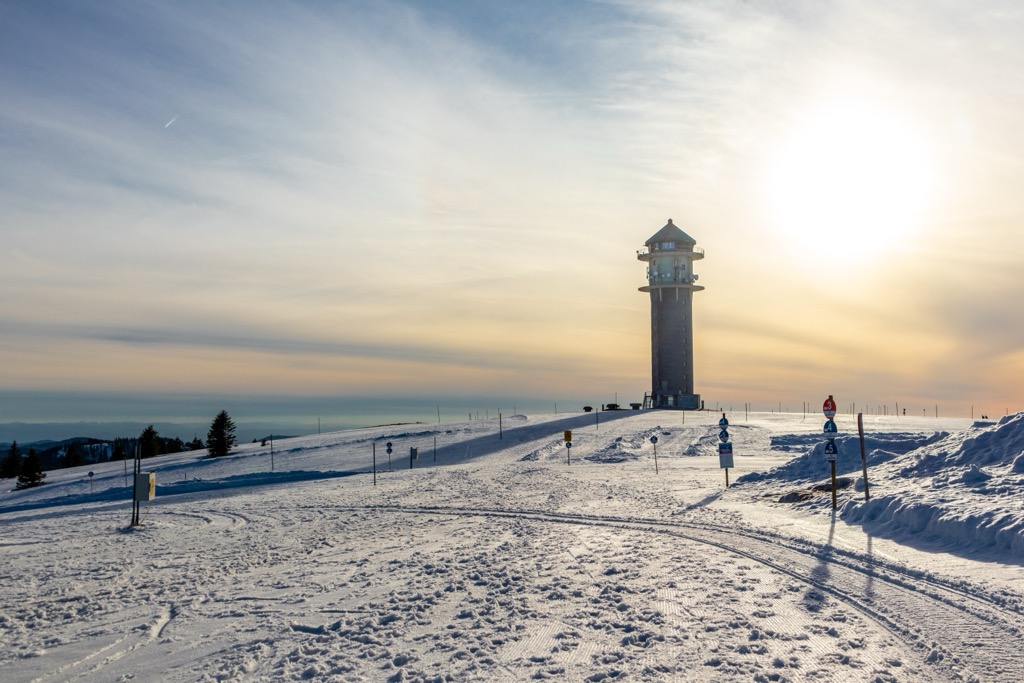
With more varied terrain and trees, Grafenmatt is the gold standard for Black Forest skiing. The most built-up part of Grafenmatt and the Feldberg Pass is home to a ski school, a few restaurants and hotels, and twin T-bars: the Grafenmatt lifts. Unlike the T-bars in Seebuck, these do not end up in the same place. Grafenmatt I —on the left if you’re facing uphill— goes up an additional 60 m (197 ft) compared to its shorter neighbor.
Both provide access to a long beginner piste and the more challenging terrain on the eastern end of Grafenmatt. Near the base is the Emmendinger Hütte, an Alpine hotel and restaurant packed with thirsty skiers on busy days.
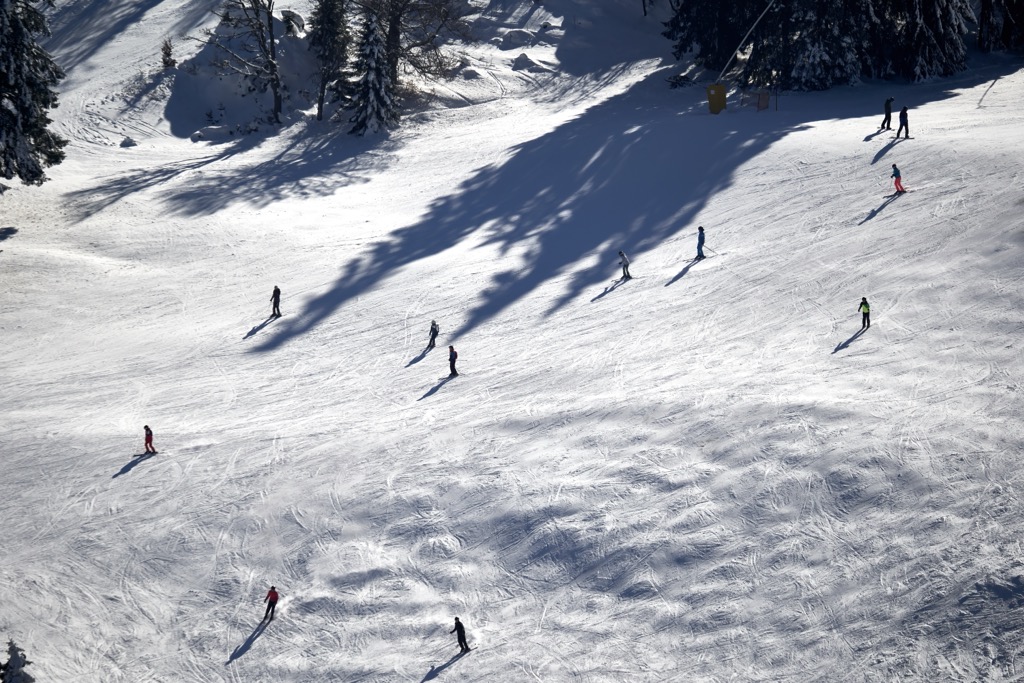
This eastern edge (the most extreme skier’s right part of the mountain) has two intermediate pistes, each about 1 km (0.6 mi) long. Note that you can extend the run by going down to the Zeigerbahn, but if you do, you’ll say goodbye to Grafenmatt. The skier’s right is the least skied part of Feldberg, and there are ample bits of terrain between the groomed pistes where powder hunters can find fresh snow. It’s served by the two Zeller T-bars (each rises about 110 m / 361 ft) and the Grafenmatt pair. That said, the short length of the runs and the fact that you’re reliant on slow T-bars does not make for very efficient skiing.
The Grafenmatt I is also your ticket to the rest of the mountain. Head skier’s left rather than straight down from the top, and you have some great options: a trio of three of the longest runs at Feldberg, one easy, one intermediate, and one advanced. After a short skate, you’ll come to a junction. Take the left route to reach Piste 11, the longest intermediate run at Feldberg. To reach an expert run or to ski the longest slope at Feldberg full stop, proceed right. You’ll reach another fork in short order. Piste 10 is the difficult-rated slope. All three join back together at the base of the Silberwiesen lift (yet another set of twin T-bars). However, Piste 9 continues, going to the Herzogenhornbahn (formerly known as the Rothausbahn) to the east.
Note that you can also reach the top of Piste 9 from the top of the Herzogenhorn chair. Ski the piste from here down to the base, and you cover 4 km (2.5 mi) with a vertical drop of 441 m (1,447 ft), the longest possible distance you’ll find at Feldberg. It’s also one of the busiest, unfortunately.
The Silberwiesen lift provides access to the same terrain and an additional intermediate run, Piste 12. The wooded area between Pistes 11 and 12 is my favorite part of Feldberg. Few skiers venture into these trees, and the snow can be quite good. Tree skiing isn’t for everyone, but the hazards here are minimal, with no cliffs or swathes of fallen trees. Like the far eastern area served by the Zeller T-bars, this area in the middle of Grafenmatt has good terrain. However, the Silber lifts rise more than twice as high as the Zeller T-bars. Moreover, you can get directly to the Zeigerhornbahn and Grafenmatt’s western fringe.
The Silberwiesen T-bars and Herzogenhorn lift end at the same spot, a gentle ridge below the summit of the Herzogenhorn summit (1,415 m / 4,642 ft). The area is also home to a guesthouse and cross-country trails.
The Herzogenhorn and the Fahlbahn serve the western edge of Grafenmatt. As a modern 4-seater, the Herzogenhorn lift is the fastest means of uphill transport you’ll find on Grafenmatt. Naturally, this makes it a great area to explore. The area has two difficult pistes, 13 and 14, the latter of which has been host to World Cup races. You can do laps on the former racecourse by riding 14 down to the Fahlbahn, or take longer runs to the Herzogenhorn’s base station.
The line under Herzogenhornbahn is also worth checking out for anyone bored of pistes. It’s not groomed, and experienced tree skiers will enjoy darting in and out of the woods in search of powder.
Broadly speaking, the tree skiing all over Grafenmatt is good, with little risk and powdery rewards. One should naturally take account of snow conditions as, depending on the weather, the untracked snow between Black Forest pines can sometimes be a crunchy nightmare. But it can also be quite soft, and shockingly few people venture into the woods, meaning there’s much more snow for those who do.
To exit Grafenmatt’s western zone, you must take the Hebelwiesen T-bar. It’s a short trip that begins below the base of the Herzogenhorn and drops skiers off at the bottom of the Silberwiesen base station. The only alternative is skating uphill. From the top of the Silberwiesen lift, you can either return to Seebuck via the Zeigerbahn or ski down to the parking lots, hotels, and bus stop at Grafenmatt’s main base area.
Slopes
Ski lifts
Other features and services
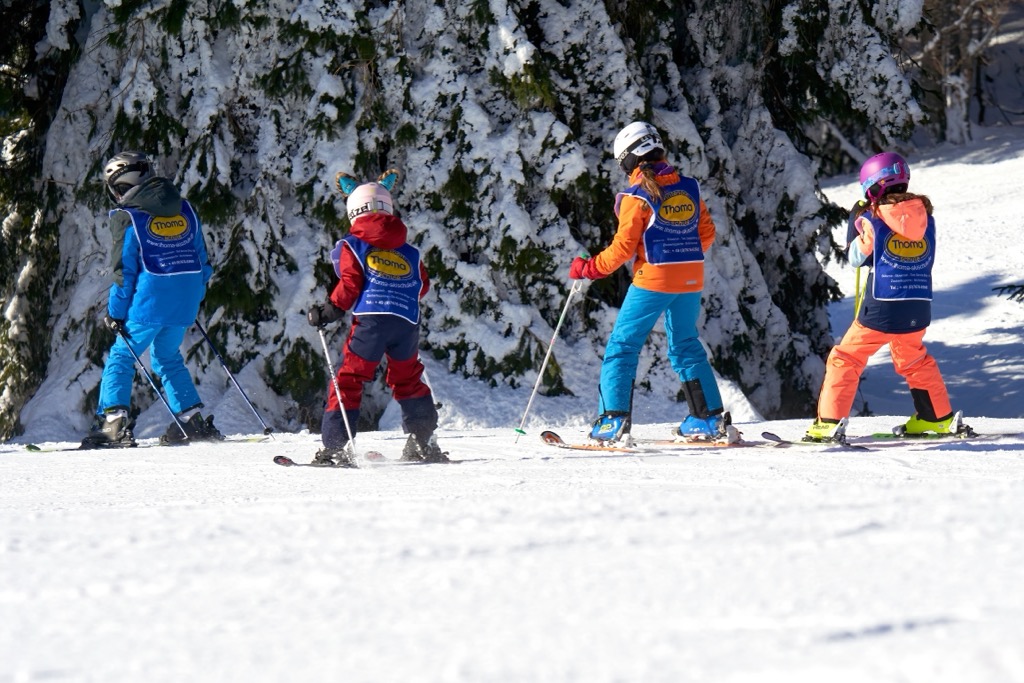
Feldberg and the surrounding country are excellent for cross-country and downhill skiers. In fact, I would say it’s even better for cross-country skiers. Feldberg has over 100 km (62 mi) of cross-country trails, including a few on or directly adjacent to the downhill area, plus many more that run through Feldberg to other mountains and villages.
The main on-mountain trails lead to the summits of the Grafenmatt and Feldberg, taking skiers above the area serviced by chairlifts. The route from the base at Seebuck runs south of the downhill area, cutting into the forest before the main ascent through the open ridge that leads to the top, passing under Seebuck tower. The summit is slightly over 3 km (2 mi) and 200 m (656 ft) above the starting point. From there, you can ski down or continue to the village of St. Wilhelm, 4 km (2.5 mi) down the line.
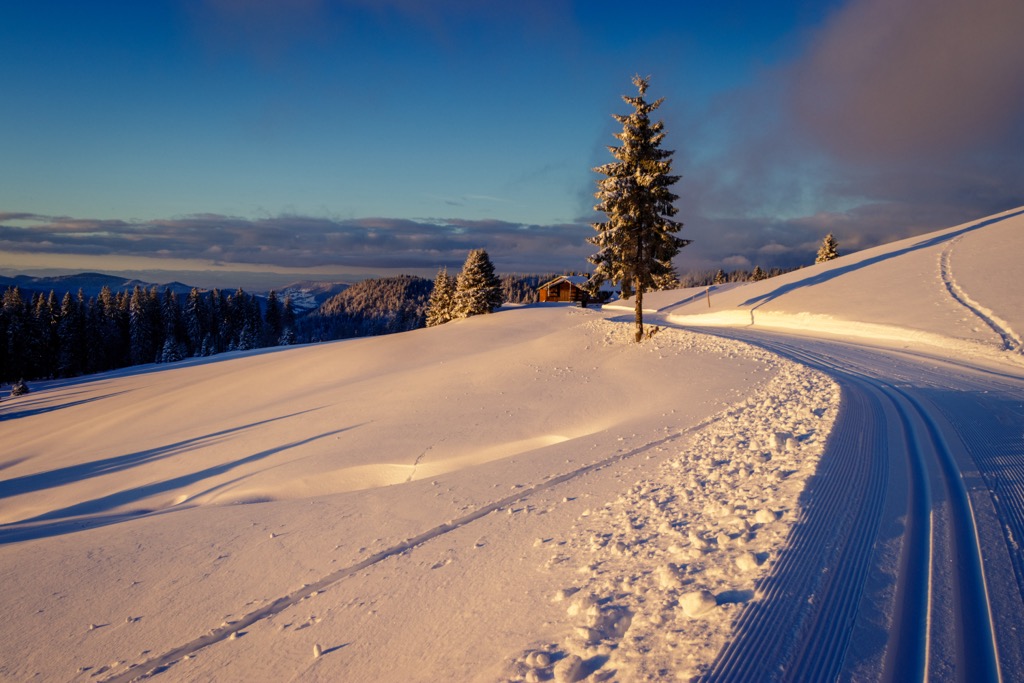
The uphill journey to the summit of the Grafenmatt is longer and spends much more time in the woods. It begins at the Grafenmatt T-bars but can also be reached from the top of the Zeller lifts. The trail veers into the Black Forest near the top of Zeller I and crosses a short valley before proceeding more or less directly to the top of the lift-accessible part of Grafenmatt. Here, at the top of the Silberwiesen and Herzogenhorn lifts, it forms a circuit that passes by a restaurant. The restaurant marks the start of the final climb and Grafenmatt’s summit.
The area has many other trails, some dozens of kilometers long. Guides to operate in the area, as do cross-country skiing schools. The Black Forest is quite scenic all year round, but the best way to experience it is (arguably) strapped into cross-country skis.
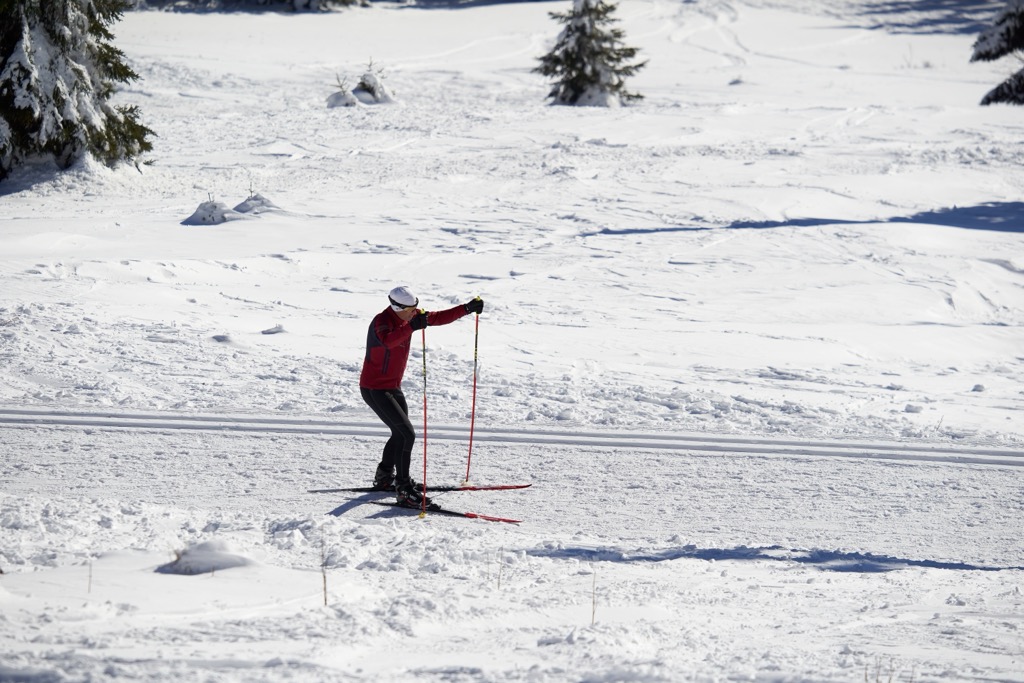
Though it only has one notable backcountry route, Feldberg does have something to offer backcountry skiers. The resort also has a few hidden off-piste runs that don’t involve making a final departure from the ski area.
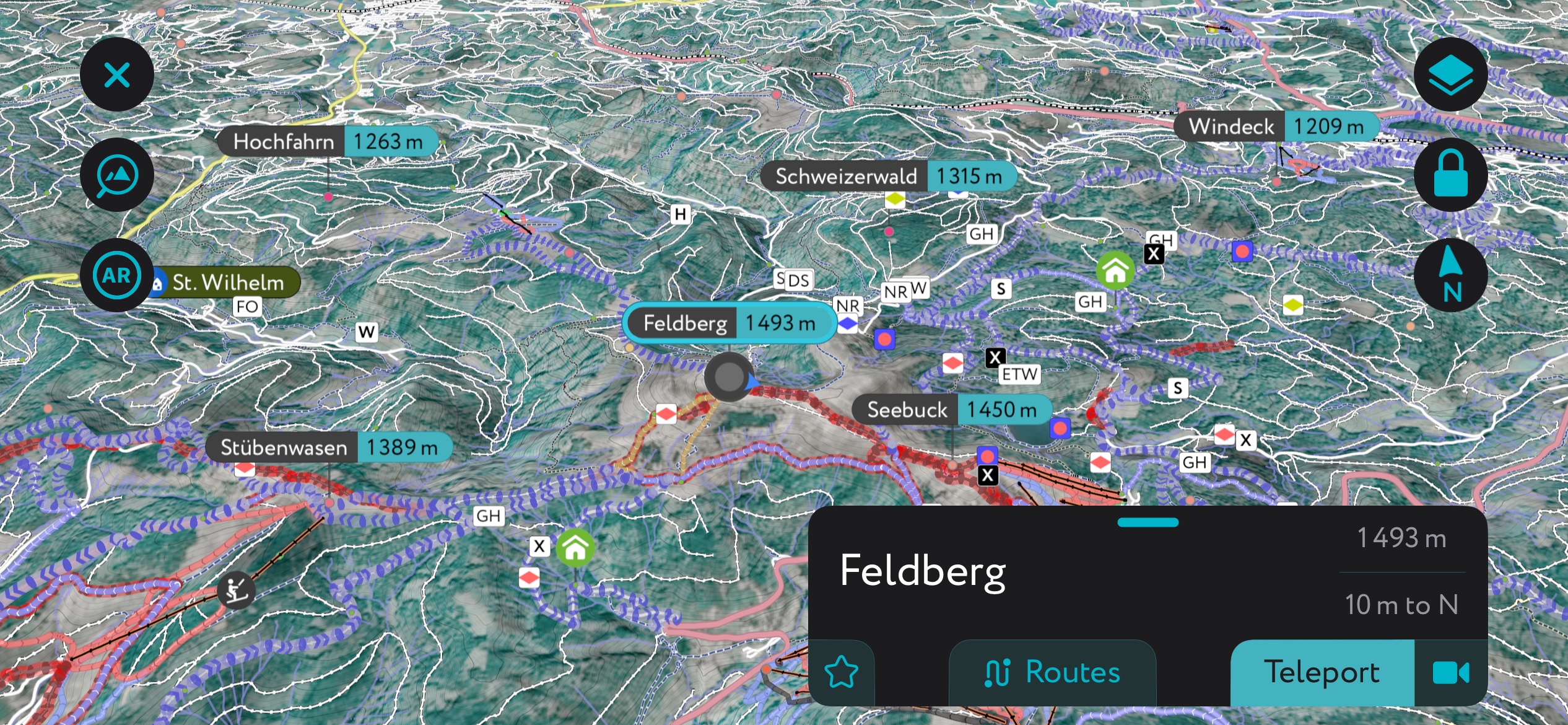
Feldberg’s single ski touring route is the Hinterwaldabfahrt, ‘Backwoods descent’ in German. Almost 10 km (6 mi) long, it runs from the top of the Grafenmatt ski area to the village of Todtnau, entailing a vertical drop of over 700 m (2,297 ft). From the top of the Herzogenhorn chairlift, head toward the summit. Turn right immediately past the ski shop. You should see signs for the run, including one indicating whether it’s open (if the sign says otherwise, there probably isn’t enough snow). You’ll want to keep your speed up at the start as this is a slight incline early on, but the skating required is minimal. From here, it’s a long and gentle run through the woods and past a handful of cabins to Todtnau.
From Todtnau, it’s a 10-minute bus ride back to the ski area. In my opinion, the commute back is well worth it, considering that the length of the run dwarfs everything else in Feldberg.
Feldberg also has options for ‘sidecountry’ skiing, defined as routes that leave the main ski area but are still more or less serviceable by lifts. I’ve already covered the tree runs on the Grafenmatt side, but there’s also an off-piste area at Seebuck. I’ve made most of my best turns at Feldberg in the woods between Seebuck and Grafenmatt. Follow the Zeigerbahn lift line till you see the cross-country trail leading into the woods. You can drop in above this point, but it’s best to take the road, especially as you learn the best lines.
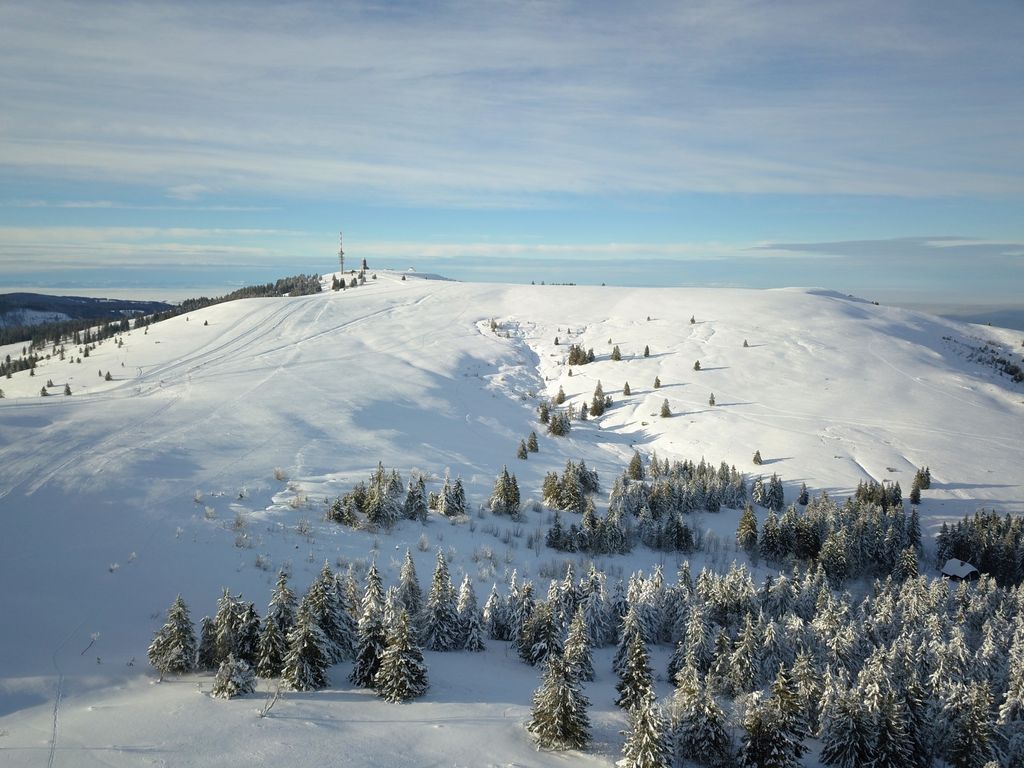
As you can see from the map, this swathe of woods goes down the valley to the Feldberg Pass road. You can’t get caught out anywhere —no hidden inclines or hazards are blocking your way. The thing to note is that this face ends at the road you’ll have to cross to get to the lifts over in Grafenmatt. In most places, the last stretch just above the road is steep. Naturally, you’ll need to tackle this slowly and carefully to avoid flying dangerously into traffic.
Whether you veer far to the right or take a straighter path, you’ll end up somewhere between the built-up area at Grafenmatt and the Herzogenhorn base station. In my experience, the best runs are found further to the skier’s right. In any case, you’ll need to cross the road and click back in on the other side. From here, it’s a short trip down to Piste 9.
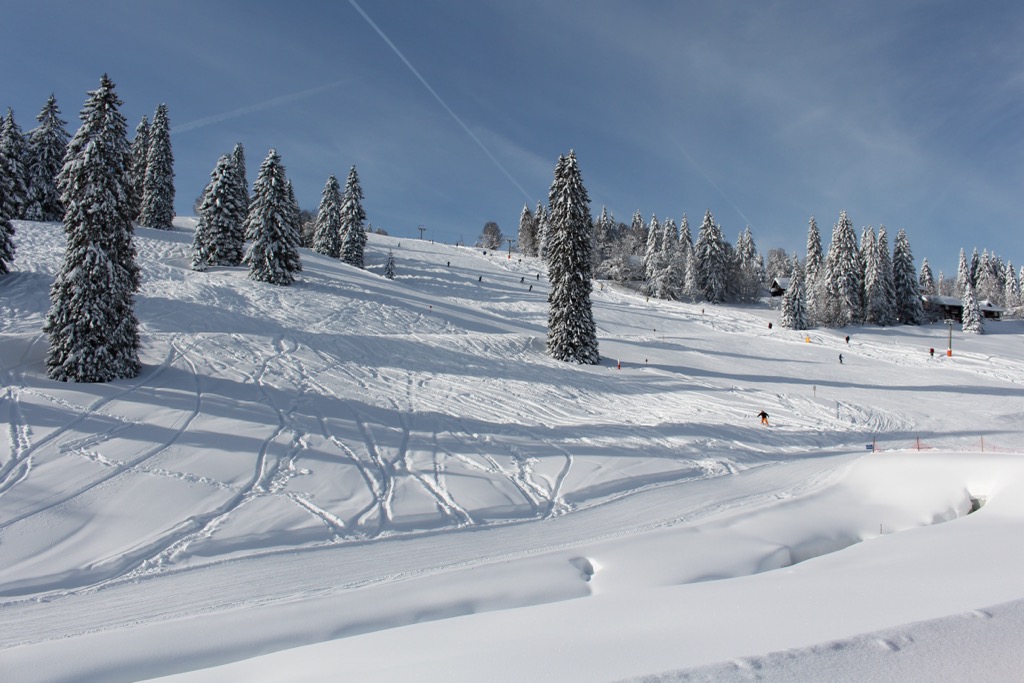
Lift tickets at Feldberg are priced very consistently, with the difference between an off-peak ticket and a peak ticket amounting to just €3. On average, a day at Feldberg costs €40 for adults and €26 for children. There are discounts when you buy more than a 1-day pass, but these are honestly negligible. First-timers can also get significant discounts, but these passes will only let you ride on a few beginner lifts. You can also save by buying afternoon passes or time-limited tickets.
Season passes for 2023/24 cost €440 for adults, with a €30 if you buy before mid-December. The price for children’s passes ranges from €260 to €60, depending on the age. Feldberg also sells discounted ‘Käpsele’ tickets. These cost €350 but are not valid on weekends and holidays.
All tickets and passes are also valid at other Black Forest resorts.

Feldberg is the preeminent attraction in the Hochschwarzwald tourism area. Visitor services are handled by this body, based in the town of Hinterzarten, just down the road from the Titisee.
Hochswarzwald Tourismus
Freiburger Straße 1, 79856 Hinterzarten
Phone: +49 (0) 7652 1206 0
Email: info@hochschwarzwald.de
There’s also a tourism office at the base of Feldberg itself, located in the Haus der Natur.
Tourist Office Feldberg
Dr.-Pilet-Spur 4, 79868 Feldberg
Phone: +49 (0) 7652 1206 0
Email: info@hochschwarzwald.de
Being a resort without much of a town, Feldberg is relatively limited when it comes to dining. I’ve already covered the eateries at the base of the lifts, but these aren’t your only options. The stretch of road between the Seebuck base and the main road has a handful of hotels and guesthouses. The largest, Feldberger Hof, has three eating establishments offering full meals. Naturally, there’s a bar as well.
Bärental, the village with the train station, has more options. Hotel Adler is my personal favorite option in the area. It serves elegant contemporary cuisine with an emphasis on fine presentation. Other venues in town include a basic Italian place (Da Rocco) and another modern restaurant, Wälder Genuss. Titisee, slightly further down the road, has more choices for food.
The huts over in Grafenmatt, along with the beer tent and Rothaus Chalet in Seebuck, offer a lively après experience when the mountain is busy. Though Feldberg is indeed small and quaint compared to what you’ll find in the Alps, you wouldn’t know it from the atmosphere at its drinking holes. The revelry can certainly match larger resorts. These all close not long after the lifts, so the opportunities for après are time-limited.
The bar at Feldberger Hof stays open late and is never empty, thanks to the fact that it’s in a hotel. Looking further afield, you won’t find anything worth mentioning in Bärental, but there are a couple of beer gardens on the shores of the Titisee.
